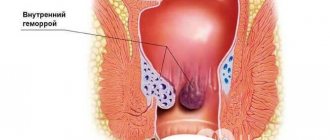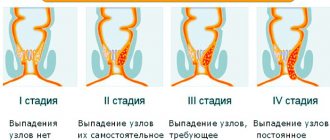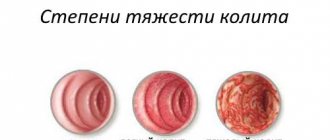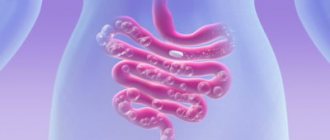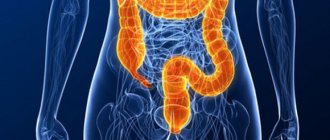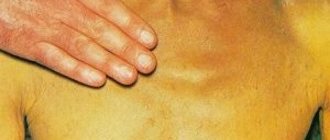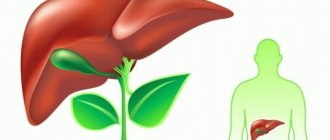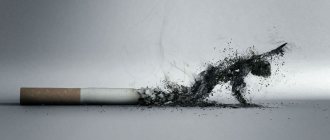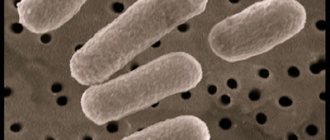Anal fissures are a disease accompanied by the appearance of a defect in the mucous membrane of the rectum (as well as subcutaneous tissue). Most often it develops against the background of chronic constipation, less often – as an independent disease.
What are the main causes of their occurrence, how to treat anal fissure and prevent relapse of the disease? Are there effective methods for preventing rupture of the rectal mucosa?
General information and reasons for its occurrence
Anal fissures develop against the background of chronic hemorrhoids (with an acute inflammatory process) or high mechanical load on the sphincter muscle ring itself.
Common causes of the disease, in addition to inflammation of hemorrhoids, are as follows:
- chronic constipation;
- lump in the anus;
- frequent diarrhea (constipation, which changes the acid-base balance of the intestinal cavity);
- fissures in the anus;
- engaging in anal sex (without observing hygiene and safety standards);
- chronic dysbacteriosis.
Doctors also indicate that anal fissure occurs during pregnancy or directly during childbirth. It is also associated with pressure on the pelvic organs due to increased weight of the fetus or its passage through the birth canal (which causes expansion of the hip joint and muscle plexuses).
According to medical statistics, defects in the rectal mucosa most often occur in mature men (from 25 to 50 years old). But, in fact, the disease can occur at any age, even in a child. But more often it goes away on its own without any therapy. And only in 15 - 20% of cases medical assistance is needed.
Causes of anal fissures
The etiology of the development of anal fissures in men and women is the increased tone of the circular muscles. The development of the defect can be triggered by:
- frequent, regular bowel movements;
- anal sex;
- traumatic damage to the mucous membrane during defecation;
- the process of obstetrics: pushing and childbirth itself, which often lead to ruptures of the mucous membrane;
- the presence of hemorrhoids;
- traumatic injuries from foreign objects: enema, proctological instrument or adult toys;
- sedentary lifestyle;
- lifting heavy weights or exerting yourself excessively;
- frequent consumption of alcoholic beverages or spicy foods;
- disorders in the functioning of the cardiovascular system and pathological conditions that are associated with them: thrombophlebitis, vasculitis, inflammatory processes of the colon, etc.;
- pathological conditions of the upper gastrointestinal tract.
Symptoms
Common symptoms of the disease:
- pain in the anus, aggravated directly by defecation;
- the appearance of a small amount of blood in the stool (pink or scarlet, not dark);
- discharge of mucus from the anus;
- increased sweating in the anus (indicates an active inflammatory process).
It is interesting that a rectal fissure is very rarely accompanied by bleeding, and massive ones are an extremely rare occurrence. With this disease, it is the mucous and submucosal part of the pararectal area that is damaged, and there are only capillaries among the blood vessels.
But there are also rectal defects combined with hemorrhoids. In this case, when there are obvious symptoms of inflammation of the hemorrhoids, massive bleeding (with dark blood - this is venous) is quite acceptable.
The best rectal suppositories
Each drug used in coloproctology to combat anal pathologies has its own ways of influencing the disease. There are healing suppositories for cracks, anti-inflammatory and painkillers. In addition, many anal suppositories strengthen veins and vessel walls, preventing bleeding and the formation of blood clots.
Today the choice of rectal suppositories is very rich
The doctor will tell you which rectal suppositories are better in this or that case and how to use them. We will make a short review of the most effective means and dwell on some of them in more detail.
Anti-inflammatory anal suppositories
Rectal suppositories with anti-inflammatory activity can contain both natural ingredients and chemicals. Plant-based preparations include extracts of medicinal herbs: chamomile, calendula, propolis, chestnut. Such products can be purchased at any pharmacy without a doctor's prescription.
The group of anti-inflammatory suppositories for rectal fissures includes:
- Posterisan Forte;
- Diclofenac;
- Rectactive;
- Calendula homeopathic;
- Betiol;
- Anuzol;
- Belladonna ex-ct (belladonna leaf);
- Procto-glivenol.
The composition of synthetic suppositories includes bismuth, hormonal substances of a steroid nature, and inactivated microbial cells of E. coli. Such drugs have many contraindications and should be used only as prescribed by a doctor.
Rectal suppositories with hydrocortisone
Suppositories with hydrocortisone are very effective for fissures in the anus. In addition to a pronounced healing result, they have an antihistamine, antipruritic and vasoconstrictor effect.
The best representative of this group is considered Relief Ultra. The medicine can be bought without a prescription, but it should be used with caution.
Anal suppositories with prednisolone
Synthetic suppositories with prednisolone are classified as glucocorticosteroid drugs. They eliminate itching and swelling in the anus, reduce discomfort and irritation.
Gepatrombin G suppositories contain prednisolone
In pharmacies, rectal suppositories with prednisolone are not widely available. The only remedy that has proven itself and is in demand is Hepatrombin G. The suppository is sold without a prescription, but, like any hormonal remedy, it has a lot of contraindications.
Rectal suppositories with analgesic effect
All drugs in this group contain a local anesthetic - anesthesin or lidocaine. Medicines have a pronounced analgesic effect. They act very quickly and eliminate discomfort in the anus within 1–2 minutes. The duration of anesthesia lasts up to 1 hour.
Anal suppositories in this category include:
- Anestezol;
- Nigepan;
- Proctosan;
- Hemorrhoids;
- Olestesin;
- Cinchocaine;
- Procto-glivenol;
- Proctosedyl:
- Hemoproct.
In addition to the active substance, pain-relieving rectal suppositories also contain some auxiliary components: sodium heparin, menthol, zinc oxide, framycetin, hydrocortisone.
Attention. When using pain-relieving suppositories, you should remember that they can only temporarily eliminate discomfort and improve the patient’s condition, but will in no way cure a fissure in the anal canal.
Wound healing rectal suppositories
The action of suppositories in this group is aimed at rapid regeneration of anal tissue, reducing swelling and irritation. In addition, suppositories relieve pain and facilitate defecation in case of cracks in the rectum.
The composition of restorative rectal products is very rich. They contain sodium alginate, sea buckthorn oil, mesalazine, fluocortolone hexonate, cinchocaine hydrochloride, propolis, bee bread, royal jelly, pollen, natural honey.
The best wound healing suppositories:
- Salofalk;
- sea buckthorn suppositories;
- Natalsid;
- Prostopin;
- methyluracil rectal suppositories
- Ultraproct.
Healing suppositories are more effective than similar tablets and ointments. Thanks to their injection directly into the site of inflammation, they are instantly absorbed and give quick results.
Types of disease
They are conventionally divided into 2 types:
- Spicy. They occur for the first time and are amenable to conservative treatment.
- Chronic. Acute wounds that have not healed within 3 to 5 weeks become chronic - the edges of the wound become rougher, covered with fibrous growths, and what doctors call a “guard tubercle” is formed. They can be treated conservatively only in 10–15% of cases; in the rest, surgery will be required.
It is impossible to find out on your own which type arose in a particular case, since it is necessary to conduct a visual examination of the pararectal area. To do this, you should seek help from a proctologist.
The most common diagnostic option is rectoscopy. The procedure itself is painless, but you will first need to thoroughly cleanse the intestines (using enemas).
Reviews about crack treatment
After giving birth, a crack formed. I was treated with relief suppositories, methyluracil, hepotrombin g, but none of this helped. I went to a proctologist, he diagnosed an acute crack.
Prescribed: 1. Manganese or herbal baths (+38C) - 1 month. three times a day for 20 minutes. 2. Daily enemas 1 liter of water + 50 ml of oil (I took flaxseed, but you can also use sunflower oil) Without skipping for 1 month 3. For 2 weeks, smear argosulfan cream 2 times a day. After two weeks at the appointment, I replaced argosulfan cream with bezornil 2 rub. in a day. During the course, I missed enemas twice and had a breakdown, pain appeared. After finishing the treatment, the doctor said that everything was fine, stop treatment, although it didn’t seem so to me, a feeling of heaviness appeared after the enemas, my intestines hurt, the doctor suggested a colonoscopy.
In tears, I called the therapist, she calmed me down and explained that the feeling of heaviness was due to the enemas, because... the intestines stretched, and after a few days constipation appeared and pain again. My doctor suggested treatment: 1) manganese baths, 2) apply tetracycline eye ointment + baby cream to dry skin in equal proportions for 5-7 days, 2 times a day, then for 3 days 1 part of hydrocortisone eye ointment and 3 parts of baby cream, lubricate with Vaseline ointment before the toilet and no enemas. Diet, kefir at night or yogurt, compote of dried fruits and vegetables. And I served a prayer for health in three churches. Everything has healed. I will be glad if it helps anyone.
Conservative treatment
Often the disease goes away on its own due to the natural regeneration of the rectal mucosa. How long does it take for a crack to heal? On average, this process takes from 3 to 10 days, it directly depends on the implementation of medical recommendations. How to treat if it still does not heal?
To do this, follow the following recommendations:
- Soften the stool. For this, it is best to include foods rich in fiber (bran, fruits, vegetables) in your diet. At the same time, foods that “fortify” should be abandoned at the time of treatment.
- Stop using toilet paper. Instead, wash yourself after each act of defecation. Maintaining hygiene is an important point in preventing the transformation of a rectal defect into a chronic form.
- Prevent sphincter spasm. It occurs due to pain during bowel movements. And it is precisely because of the repeated spasm that the wound that has not yet healed occurs again. Warm baths (with chamomile and oak bark), nitroglycerin ointment (prepared directly at the pharmacy), and suppositories with belladonna extract will help prevent spasms and relieve pain.
As for pharmacological agents, healing and antibacterial drugs should be used. Suppositories and ointments for hemorrhoids are not always suitable.
More often doctors prescribe:
- Candles with belladonna extract. They eliminate spasms and also irritate the intestines, stimulating bowel movements (important for constipation, including those occurring against the background of a painful symptom).
- Methyluracil suppositories and ointment. Stimulates the regeneration of the mucous and submucosal membranes, strengthens local immunity.
- Levomekol (in the form of a compress and tampons). It is a mixture of methyluracil as well as an antibiotic that prevents infection of the open wound.
Treatment of anal fissure at home will only be effective at the early stage of the disease. If pain during defecation makes itself felt for more than the first month, then you should definitely consult a doctor.
It is worth considering that the symptoms of the disease are extremely similar to rectal cancer, but only a proctologist can make an accurate diagnosis.
What does traditional medicine say?
Treatment with folk remedies is also allowed. The following are effective:
- Sitz baths with a strong decoction of oak bark. Heals the wound, relieves pain.
- Compresses with grated potatoes. Due to tannin it gives a tanning effect and eliminates pain.
- Prune jelly. An excellent laxative that softens stool.
It is also important when treating defects in the rectal mucosa to drink as much water as possible (3 liters per day). This indirectly helps normalize stool.
Surgical treatment methods
Chronic anal fissure is practically not amenable to conservative treatment; the only option is surgery. It is performed using both a laser and an electronic knife.
But the principle is the same everywhere - this is excision of the anal fissure, in which its fibrous edges are cut off, smoothed, and then a compress with drugs that accelerate regeneration is applied to the wound. The operation itself takes 10–30 minutes (depending on the instruments used), hospitalization is not required.
After the operation, sick leave is issued for 5–10 days. During this period, you need to perform dressings yourself, eliminate physical activity, and follow a gentle diet. As a rule, after the operation, the pain is eliminated immediately, but discomfort is felt over the next 3 to 5 weeks. This is normal.
Removal and excision of the defect is the only correct treatment option with a 100% guarantee of a positive result. But no one is protected from relapse of the disease. Moreover, the likelihood of its occurrence directly depends on the patient himself.
Classification
Regardless of the cause, the disease can occur:
- in acute form;
- in a chronic form.
If the disease occurs in an acute form, it means that the damage appeared not so long ago. The tissues are bright red in color, there are no clear boundaries, and granulation is not observed. In this case, the disease will be treated using conservative therapy, that is, using medications of various spectrums of action, but without surgery.
If we talk about the chronic form of the course, then in this case it will be necessary to carry out surgical intervention, excision of the anal fissure and damaged tissues that have undergone granulation in the affected area.
Signs of a chronic form of the disease:
- Damaged tissues have a clear localization (borders).
- Signs of granulation appeared on the integument.
- The damage does not heal over a long period of time.
In such a situation, conservative therapy is prescribed after surgery. The recovery period will not take much time if you follow all the doctor’s recommendations.
Prevention
It is possible to prevent cracks in the anus in adults and children. To do this, follow the following recommendations:
- Avoid anal sex. As a last resort, use a water-based lubricant (and as much as possible, because the rectum itself produces mucus in small quantities).
- Maintain a healthy diet. It includes vegetables and fruits, but consume fatty meats and protein foods to a minimum.
- Physical exercise. Help prevent blood stagnation in hemorrhoids and their subsequent inflammation.
- Do not let constipation progress to a chronic stage. At the first sign of difficulty in defecation, it is better to use a microenema or use a Vaseline suppository.
Conclusion
Overall, anal fissures occur at any age. They are amenable to conservative treatment only in the acute stage - in the first days after their appearance. Chronic (acute ones transform into them after 3 - 5 weeks) doctors recommend treating them surgically by excision.
Drugs
The basis of conservative treatment of anal fissures is local remedies - rectal suppositories. The range of suppositories is huge; they are of natural and synthetic origin, often have a multi-component composition and are used to eliminate all the main symptoms of the disease.
The best suppositories for the treatment of anal fissures should have analgesic, hemostatic and wound-healing effects.
What drugs are used most often:
- Ultraproct is a combination of glucocorticoid hormone and anesthetic;
- Relief Ultra - contains shark liver oil (accelerates tissue regeneration), phenylephrine (vasoconstrictor and hemostatic effect) and hydrocortisone (anti-inflammatory effect);
- Relief Advance – provides pain relief and wound healing;
- Posterizan - have an immunostimulating effect, promote the restoration of injured mucosa and the healing of cracks;
- Natalsid is a herbal preparation made from brown seaweed, prevents bleeding and heals defects in the mucous membrane, is effective and safe for pregnant women and nursing mothers;
- propolis-based suppositories - have analgesic, hemostatic and regenerating effects;
- suppositories with sea buckthorn - relieve inflammation, have an antibacterial and regenerating effect, this remedy is suitable for children, the elderly and pregnant women.
Very important in treatment is the correct use of suppositories according to the instructions and recommendations of the doctor. Before administration, the suppository should be slightly warmed in your hand to soften it. After insertion, you cannot immediately push the suppository deep into the rectum; you must hold it for several minutes in the anal canal - the main point of application.
In many cases, it is not possible to quickly recover due to severe spasm of the sphincter. What to do in this case? Nifedipine and Nitroglycerin ointment is used topically in a concentration of 0.2-0.4% for application to the affected area in the morning and evening. Old proven methods that are still used by proctologists are blockades - the injection of a small amount of lidocaine under the crack, followed by the use of Solcoseryl. The procedures are repeated according to individual schemes, for example, once a week. A contraindication is the combination of an anal fissure with hemorrhoids.
